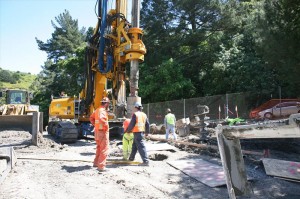Construction crews are busy at work on the east and west sides of the tunnel, building the portal walls and retaining walls to hold back the hillsides. Most of this work has to be completed before excavation of the tunnel can actually begin.
According to caldecott-tunnel.org, each portal wall is being built as a secant wall, a method where the retaining wall is built underground and later excavated. First, a series of holes are drilled into the earth several feet apart. A steel cage is inserted into each hole, then filled with concrete, forming a “cast in drilled hole” pile. Once the piles have hardened, new holes are drilled between the existing piles, so they overlap the existing piles by about six inches on both sides. When the new pile is hardened, it will interlock with the existing piles, forming a sturdy underground wall.
In time, the subterranean wall will be excavated, revealing the load-bearing wall of the portals. The wall is said to be strong enough that it will drill through to form the entrance to the tunnel. Lastly, another concrete wall will be cast over the face of the secant wall, providing additional strength and a surface over which architectural details can be rendered.
The retaining walls are built perpendicular to each portal wall to hold back the hillside. According to Caldecott-tunnel.org, holes are drilled into the hillside, a steel bolt (soil nail), is inserted, then grout is injected into the hole and allowed to harden. The bolts will protrude through the face of the wall, and will be tightened, pulling the wall tightly against the hillside.
Source:

